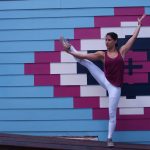Vrksasāsana, or tree pose, is truly one of the most recognisable and iconic of yoga poses. It is a wonderful hip and core strengthener; develops balance and teaches focus. Done well it is incredibly grounding and fits equally well in a class or as a stand-alone pose to calm and soothe. Want to know how to grow your tree? Here’s how…
Growing Your Tree
Start from a strong Tadāsana (mountain pose) with attention to both grounding through feet and length of the spine through the crown of the head. Pour your weight into one leg and continue to grow tall from ground to crown. Bend the lifted knee up forwards towards the chest then rotate the hip outwards to place the foot flat on the inner, upper thigh. Using your hands to assist placing the foot is perfectly acceptable (and necessary for many of us!). The foot should be well above the knee to prevent excess force on the joint. Now firmly press the foot into the thigh and the thigh into the foot to create a really stable, strong foundation.
In this pose, the pelvis ideally faces forwards with the knee out to the side but not everyone has hips that will allow this. For those with tight hips (like me) – aim for a knee position that allows the pelvis to point forwards and graciously accept a more forward pointing knee. Now it is time to check in to see if you are still growing tall through the standing leg and take a moment to lengthen the spine once more. Then when you are ready, inhale the arms overhead and stretch the fingers skywards and you draw the shoulder blades down and together to create space around the ears.
And there you have it – your perfect tree.
Nurturing Your Tree
But what about those of us who struggle with balance poses and tree pose in all its glory? And, yes, I am one of those yogis. I simply cannot keep my foot planted on my thigh for more than a few seconds before it slips painfully off towards my knee. So what do I do? Well, I modify, modify, modify and keep practicing my version of tree. Remember that the journey from seed to sapling to mature tree is a long one in nature and your journey to vrksāsana may be equally long. Here are a few steps to help you on your way.
- Sitting tree – a seated version of the pose can be a great place to start for yogis with disability or balance issues that make a standing version inaccessible. Ground through both sitting bones just as you would through feet in standing then everything above is exactly the same.
- Toe touch tree – Here the lifted foot is placed on the inner side of the standing ankle with the big toe just touching the floor. This add a surprising amount if stability and can make vrksāsana accessible to yogis who struggle with single leg balances.
- Foot below knee tree – This version has the foot placed on the inner shin, below the knee, and is great for yogis with reduced knee flexion (bend) and/or tight hips. Please remember that the foot is below the knee – never at knee level – to protect the joint.
- Supported tree – placing a hand on a wall or window sill while you get the leg placing and balance sorted out can be really useful for any of the tree variations. Alternatively, stand sideways on to a wall so that you are supported at the widest part of your hips as you build your tree.
So Many Types of Tree
Traditionally the arms are overhead in a sort of Y-shape in vrksāsana. The hands are like branches reaching for the sun as the shoulder blades are reaching down towards the earth – a lovely example of dual action at work. But why be restricted by tradition when yoga is about adapting poses to our bodies and evolving practice. Here are a few of my favourite arm variations for tree pose.
- Hands on hips – really nice for novice yogis to help stabilise the pose as they find their feet ( or should I say ‘roots’?).
- Prayer hands – bringing the hands together, palms flat, in front of the chest adds a challenge from the last version but still offers an element of stability (and is my current favourite!). You can press the palms together to increase core engagement then reduce the pressure in preparation to move on to a more challenging arm position if you want to.
- Thumbs in ‘braces’ – imagine you are wearing dungarees and getting ready to ‘hoe-down’ like a cowboy here. This version is great for tight shoulders (and aways makes me smile).
- Cactus arms – here the arms are held out to the sides at shoulder height with elbows bent and fingers pointing to the ceiling – like in goddess pose. This version opens the chest and can help to lift the rib cage in the pose.
And for that extra challenge…
These are for this times when you really want a challenge or (some fun).
- Waving tree – imagine your tree is being blown in the wind from side to side. Rock the whole body one way then the other as you are buffeted by the gusts and see how far you can go before gravity takes over and topples your tree.
- Moving tree – No, I don’t mean the Ents from Lord of the Rings (for any Tolkien fans…). What I mean is to move from your lovely tree into a different single leg standing balance – possibly virabhadrāsana 3 (warrior 3) or Utthita Pādāṅguṣṭhāsana (extended hand toe pose) – then back again maybe … a few times?! This is a fabulous way to strengthen the muscles of the standing hip through a range of movement and will work wonders for your dynamic balance skills. It usually raises a giggle in a class too as yogis wobble and topple left right and centre.
So there is a truly veritable forest of tree poses for your delight and delectation – something for everyone to try. Inn these times where we are being exhorted to plant more trees to save the environment, maybe we could add some yoga trees to benefit us and those around us. I’m sure it ‘wood’ help…












